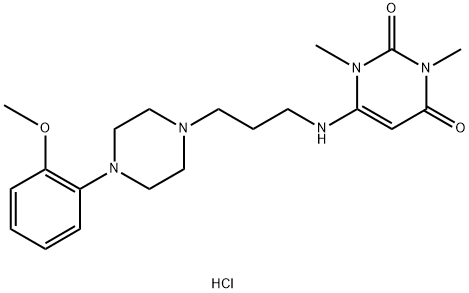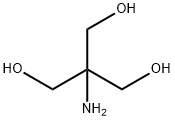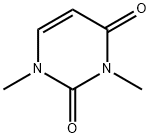Urapidil hydrochloride
Synonym(s):6-[[3-[4-(o-Methoxyphenyl)-1-piperazinyl]propyl]amino]-1,3-dimethyluracil hydrochloride
- CAS NO.:64887-14-5
- Empirical Formula: C20H30ClN5O3
- Molecular Weight: 423.94
- MDL number: MFCD00078601
- EINECS: 636-348-0
- SAFETY DATA SHEET (SDS)
- Update Date: 2025-12-16 16:15:04

What is Urapidil hydrochloride?
Description
Urapidil is an antagonist of α1-adrenergic receptors (α1-ARs) and a partial agonist of the serotonin (5-HT) receptor subtype 5-HT1A. It selectively binds to α1- over α2-ARs (IC50s = 0.74 and 42 μM, respectively) and to 5-HT1A over 5-HT1B and 5-HT2 receptors (IC50s = 0.4, 20.4, and >10 μM, respectively) in rat cortex. Urapidil inhibits cAMP accumulation induced by forskolin in calf hippocampus as a functional model for 5-HT1A receptors (EC50 = 390 nM). It is also a β1-AR antagonist that inhibits the positive chronotropic response induced by isoproterenol in isolated rat atria (pA2 = 6.05). Urapidil (1 μmol/kg, i.v.) lowers mean arterial pressure (MAP) in anesthetized cats, an effect that is reduced by central administration of the 5-HT1A receptor antagonist spiroxatrine.
Chemical properties
White to Off-White Crystalline Powder
The Uses of Urapidil hydrochloride
a1-Adrenergic antagonist; derivative of Uracil. Antihypertensive
The Uses of Urapidil hydrochloride
α1-Adrenergic antagonist; derivative of Uracil (U801000). Antihypertensive.
The Uses of Urapidil hydrochloride
Antihypertensive;Serotonergic receptor agonist
What are the applications of Application
Urapidil HCl is an adrenergic α1-AR antagonist and a serotonin 5-HT1A (SR-1A) receptor agonist
Biological Activity
α 1 -adrenoceptor antagonist and 5-HT 1A receptor agonist (pIC 50 values are 6.13 and 6.4 respectively). Clinically used hypotensive agent.
Side Effects
Side effects that may occur during treatment with uradil antihypertension include dizziness, fatigue, nausea, and light-headedness effects. The increases in systolic blood pressure heart rate caused by three progressive work loads bicycle exercise were not affected during urapidil, A slight reduction in forced expiratory volume was observed in some patients during treatment with beta-blocker. There was no case orthostatic hypotension during urapidil administration, despite its alpha1-blocking action. Side-effects were rare negligible[1].
References
[1] G LEONETTI. Comparison of the antihypertensive effect of urapidil and metoprolol in hypertension.[J]. European Journal of Clinical Pharmacology, 1986, 30 6: 637-640. DOI:10.1007/BF00608208.
Properties of Urapidil hydrochloride
| Melting point: | 156-1580C |
| storage temp. | Keep in dark place,Inert atmosphere,Room temperature |
| solubility | H2O: soluble |
| form | solid |
| color | white |
| Water Solubility | Soluble to 50 mM in water |
| InChI | InChI=1S/C20H29N5O3.ClH/c1-22-18(15-19(26)23(2)20(22)27)21-9-6-10-24-11-13-25(14-12-24)16-7-4-5-8-17(16)28-3;/h4-5,7-8,15,21H,6,9-14H2,1-3H3;1H |
Safety information for Urapidil hydrochloride
| Signal word | Warning |
| Pictogram(s) |
 Exclamation Mark Irritant GHS07 |
| GHS Hazard Statements |
H302:Acute toxicity,oral |
| Precautionary Statement Codes |
P264:Wash hands thoroughly after handling. P264:Wash skin thouroughly after handling. P270:Do not eat, drink or smoke when using this product. P301+P312:IF SWALLOWED: call a POISON CENTER or doctor/physician IF you feel unwell. P501:Dispose of contents/container to..… |
Computed Descriptors for Urapidil hydrochloride
| InChIKey | KTMLZVUAXJERAT-UHFFFAOYSA-N |
| SMILES | O(C1C=CC=CC=1N1CCN(CCCNC2=CC(=O)N(C)C(=O)N2C)CC1)C.Cl |
New Products
Indole Methyl Resin tert-butyl 9-methoxy-3-azaspiro[5.5]undecane-3-carboxylate Boc-His(Boc)-OH 2-CTC Resin 4-Chloro-7-tosy1-7Hpyrrolo[2,3-d]pyrimidine 5,7-Dibromo-1H-indole 2,5-dichloro-N-hydroxy-4,6-dimethylpyridine-3-carboximidamide 2,2-Dimethoxy-7-azaspiro[3.5]nonane hydrochloride 4-chloromethyl-5-methyl-1,3-dioxol-2-one (DMDO-Cl) R-2-BENZYLOXY PROPIONIC ACID 1,1’-CARBONYLDIIMIDAZOLE 1,1’-CARBONYLDI (1,2-4 TRIAZOLE) N-METHYL INDAZOLE-3-CARBOXYLIC ACID 4-((2-hydroxyethyl)thio)benzoic acid 1-(TERT-BUTOXYCARBONYL)-2-PYRROLIDINONE Methyl 6-methylnicotinate 3-Pyridineacrylic acid tert-Butyl carbazate TETRAHYDRO-2H-PYRAN-3-OL 2-((4-morpholinophenylamino) (methylthio) methylene) malononitrile 3-(4-morpholinophenylamino)-5-amino-1H-pyrazole-4-carbonitrile 2,4-dihydroxybenzaldehyde 1,3-Diethyl-1,3-Diphenylurea Methyl 2-methylquinoline-6-carboxylateRelated products of tetrahydrofuran
![6-[[3-[4-(2-Methoxyphenyl)-1-piperazinyl]propyl]amino]-1,3-dimethyluracil](https://img.chemicalbook.in/CAS/GIF/34661-75-1.gif)







You may like
-
 64887-14-5 Urapidil hydrochloride 98%View Details
64887-14-5 Urapidil hydrochloride 98%View Details
64887-14-5 -
 Pyridine 99.5% HPLC /UV SpectroscopyView Details
Pyridine 99.5% HPLC /UV SpectroscopyView Details
110-86-1 -
 Guanine , 99%View Details
Guanine , 99%View Details
73-40-5 -
 Piperazine Spot supply, best priceView Details
Piperazine Spot supply, best priceView Details
110-85-0 -
 Dibutyl PhthalateView Details
Dibutyl PhthalateView Details
84-74-2 -
 Imidazole Spot supply, competitive priceView Details
Imidazole Spot supply, competitive priceView Details
288-32-4 -
 Octadecyl 3-(3,5-di-tert-butyl-4-hydroxyphenyl)propionate 98% (GC)View Details
Octadecyl 3-(3,5-di-tert-butyl-4-hydroxyphenyl)propionate 98% (GC)View Details
2082-79-3 -
 Thiourea 99% ARView Details
Thiourea 99% ARView Details
62-56-6
